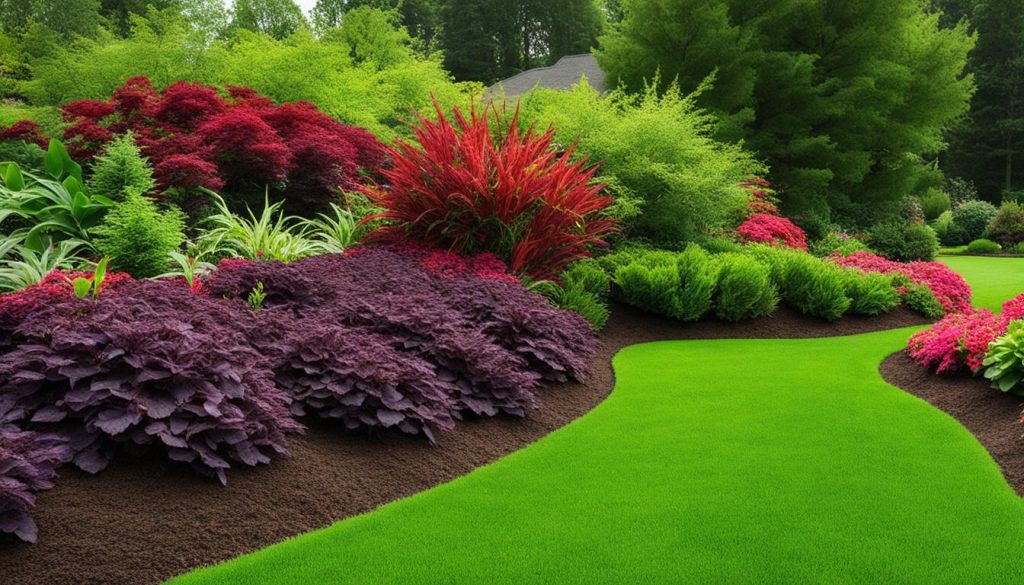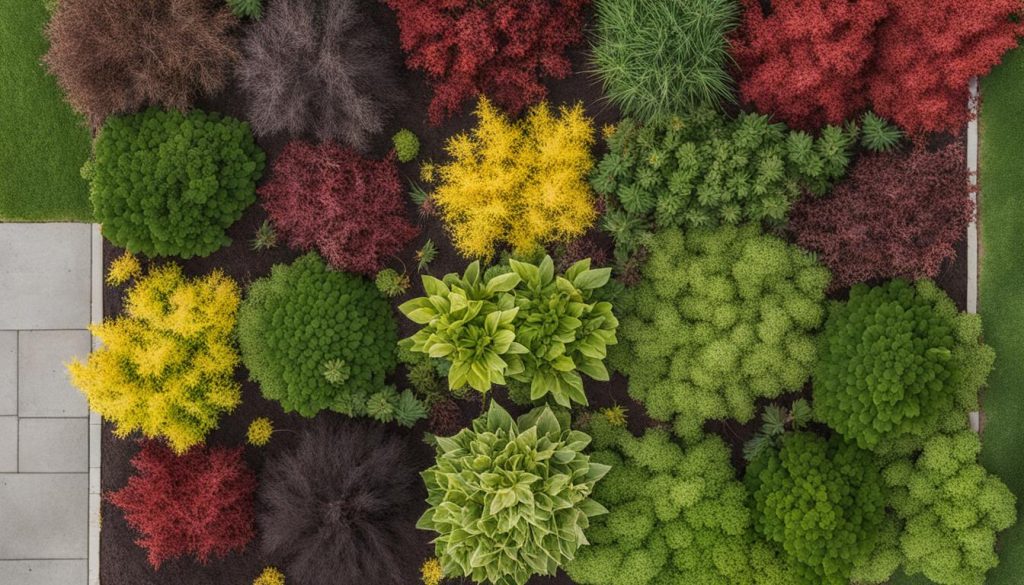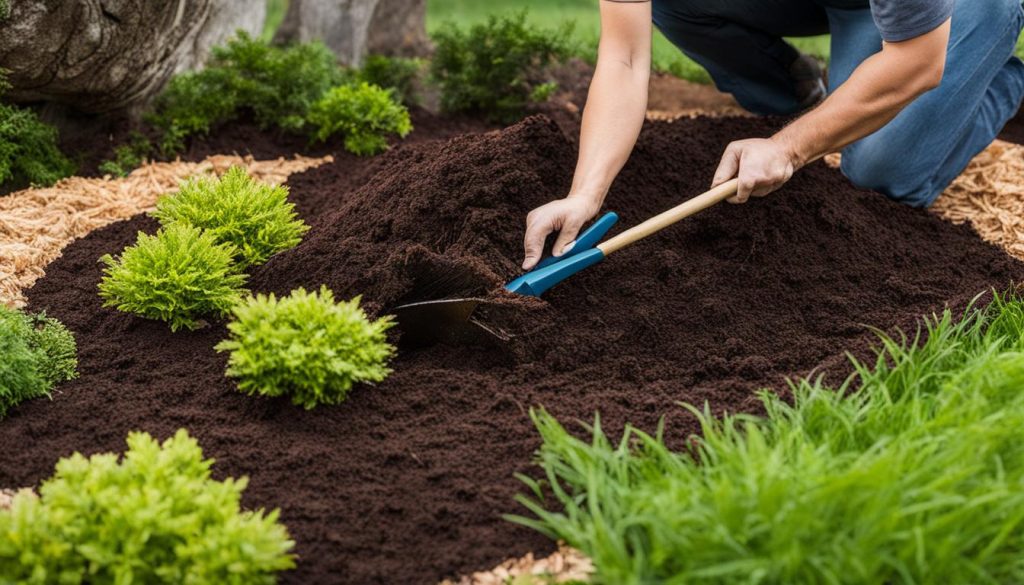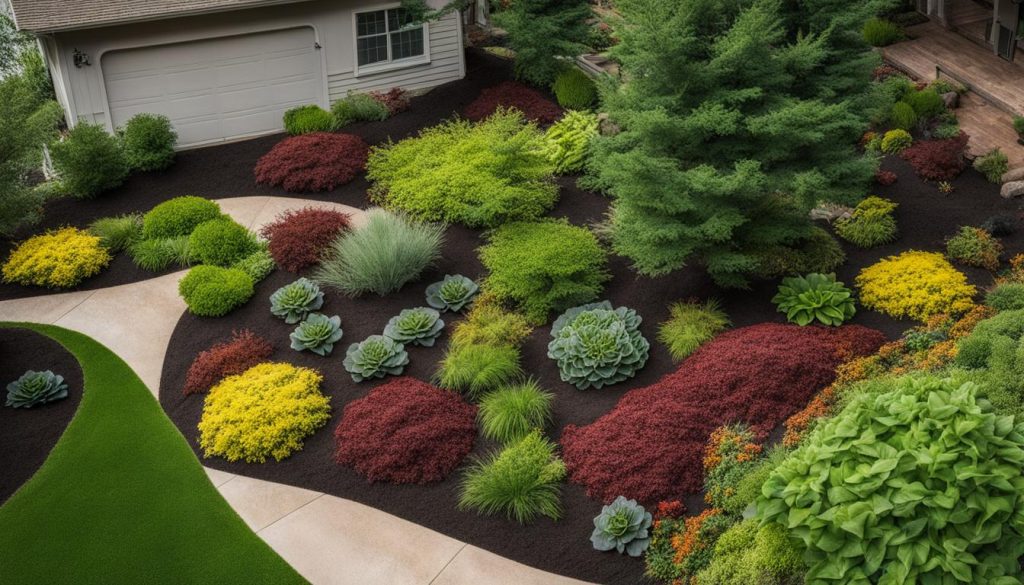Are you looking for ways to enhance the health and beauty of your garden? Look no further than landscaping mulching! Mulching is a popular technique used to promote healthy plant growth and improve the appearance of your landscape.
In this section, we’ll explore the various benefits of mulching in landscaping and provide you with tips and techniques to make the most out of this useful gardening practice. Whether you’re a seasoned gardener or just starting out, this guide will provide you with all the information you need to get started with mulching.
Key Takeaways:
- Mulching is a popular technique used to promote healthy plant growth and improve the appearance of your landscape.
- Using the correct type of mulch is essential in order to maximize the benefits of mulching.
- Proper mulching techniques, including preparing the soil and applying the mulch correctly, can help ensure success in your gardening efforts.
- Mulching can help conserve water, reduce weed growth, and protect plants from extreme temperatures.
- With careful attention and maintenance, mulch can help keep your garden looking beautiful for years to come.
The Importance of Mulching in Landscaping
At Landscaping Near Me, we cannot emphasize enough the importance of mulching in landscaping. Not only does it contribute to the overall health and look of your yard, but it also offers several benefits that support your garden’s growth and longevity.
Garden Health
Mulching promotes garden health by providing insulation to plants and soil. It helps keep the temperature of the soil consistent, protecting plants from extreme heat and cold. Mulching also helps retain moisture in the soil by reducing water evaporation, ensuring that plants receive consistent hydration and reducing the need for additional watering.
Landscaping Benefits
Mulching offers numerous benefits to your landscaping. It helps to suppress weed growth, reducing the need for manual weed removal, and preventing weeds from competing with plants for nutrients. Mulching also supports soil health by improving its structure, nutrient content, and aeration, making it easier for plants to grow roots and access vital nutrients.
Choosing the Right Mulching Materials
Choosing the right mulching materials is essential to ensure optimal benefits. Organic materials, such as bark chips and compost, provide natural nutrients, contribute to soil health, and break down over time, creating a beneficial layer of humus. Inorganic materials, such as stone, rubber, or gravel, offer long-lasting and low-maintenance options, reducing the need for frequent replacement.

Proper Mulching Techniques
To achieve maximum benefits, proper mulching techniques must be applied, such as maintaining the proper thickness and coverage based on the specific needs of your garden. Always prepare the soil before applying mulch, ensuring it is level, moist, and weed-free. Avoid creating mulch volcanoes, which are excessive piles around plants, as they can cause damage to the plant’s bark and roots.
Incorporating Mulching Into Your Landscape
Mulching can be incorporated into several areas of your landscape, making your garden visually appealing while enhancing its health. Flower beds, tree bases, vegetable gardens, and pathways can all benefit from mulching. Applying different types of mulch in different areas can also create an interesting and diverse landscape look.
In conclusion, mulching is a fundamental practice in landscaping that offers several benefits to your garden’s health and beauty. By choosing the right materials and techniques, you can create a sustainable, low-maintenance garden that flourishes year-round.
Types of Mulch for Landscaping
Choosing the right type of mulch is an essential aspect of landscaping that can make a significant difference in the overall health and beauty of your garden. There are two main types of mulch that we recommend: organic and inorganic.
Organic Mulch
Organic mulch is made from natural materials that decompose over time, providing essential nutrients to the soil. This type of mulch is ideal for those who want to improve the fertility of their garden while also preventing weed growth and conserving water.
Some popular types of organic mulch include:
| Type of Organic Mulch | Description |
|---|---|
| Bark Chips | Extracted from various tree barks, these chips are ideal for creating a natural, rustic look in your garden. They are also excellent for retaining moisture and suppressing weed growth. |
| Compost | A mixture of decomposed organic materials, compost is an excellent natural fertilizer that enriches the soil and improves its structure. Compost also helps in suppressing weed growth and conserving moisture. |
| Leaves | Dried leaves can be an excellent source of organic mulch, especially during the fall season. Leaves break down over time, releasing essential nutrients to the soil while also suppressing weed growth and conserving moisture. |
When using organic mulch, it is essential to properly prepare the soil by removing any weeds or debris before applying the mulch layer.
Inorganic Mulch
Inorganic mulch is made from non-natural materials that do not decompose over time, making them long-lasting and ideal for areas where erosion is a concern. Inorganic mulch is also excellent for use in pathways or areas with heavy foot traffic, where organic mulch may break down quickly.
Some popular types of inorganic mulch include:
- Gravel
- Stone
- Rubber Mulch
- Landscape Fabric
When using inorganic mulch, it is essential to properly layer the material to ensure adequate coverage and protection from weeds and erosion.

No matter what type of mulch you choose, it is essential to properly apply and maintain the mulch layer to maximize its benefits. We recommend applying a layer of mulch 2-3 inches deep and replenishing the layer annually to ensure optimal performance.
Techniques for Mulching in Landscaping
Proper mulching techniques are essential for the health and appearance of your garden. Here are some tips to ensure you apply mulch correctly.
Preparing the Soil
Before mulching, it’s important to prepare the soil to ensure the mulch can do its job correctly. Rake the area to remove any debris, and water the soil to provide a moist base. If necessary, add fertilizer to the soil to provide the necessary nutrients for healthy plant growth.
Applying Mulch
When applying mulch, make sure you apply it in a layer that is between two and four inches thick. This depth will provide adequate protection for the soil and plant roots and inhibit weed growth. Ensure that the mulch is not too close to the stem or trunk of the plant to avoid rot and disease.
You should also consider the type of mulch you are using when applying it. For example, finely shredded bark mulch should be applied in thinner layers than coarser wood chips or straw.
Maintaining the Mulch
Once you’ve applied the mulch, it’s important to maintain it properly. Keep it moist, but not soaking wet, to help it provide moisture to the soil. We recommend watering the mulch lightly after first application, then checking every two to three days to see if the mulch needs moisture.
It’s also a good practice to periodically rake the mulch to break up any compacted areas and ensure an even layer. If you notice the mulch layer becoming thin, add more to maintain the desired depth.

Incorporating proper mulching techniques in landscaping will help your garden look and thrive beautifully. Take care to prepare the soil, apply the mulch correctly, and maintain it appropriately to obtain the best results.
Enhancing Your Garden with Mulching
Now that we’ve discussed the various benefits and techniques of mulching in landscaping, let’s explore some additional tips and ideas for enhancing your garden with this practice.
Creating Visual Appeal
Mulching can play a significant role in creating visual appeal in your garden. By using mulch to define the borders of your flower beds, you can easily add a polished look to your landscaping. Consider using contrasting colors to create a dramatic effect, or stick to a more uniform color scheme for a cohesive look.
Improving Moisture Retention
One of the biggest benefits of mulching is its ability to help retain moisture in your soil. This is especially important in hot and dry climates, where water conservation is a top priority. By applying a layer of mulch around your plants and trees, you can help prevent evaporation and ensure that your garden stays hydrated.
Protecting Plants from Extreme Temperatures
In addition to retaining moisture, mulch can also provide insulation for your plants during extreme temperature fluctuations. Whether it’s protecting them from scorching heat or freezing cold, a thick layer of mulch can help keep your garden healthy and thriving year-round.
Choosing the Right Mulch for Your Garden
When it comes to choosing the right mulch for your garden, there are a few factors to consider. Organic options, such as bark chips and compost, are great for improving soil health, while inorganic options like gravel and rubber mulch can offer longer-lasting durability. Consider the aesthetic you’re going for, as well as the specific needs of your plants, when selecting the right type of mulch for your garden.
Applying Mulch Properly
Proper application of mulch is key to reaping all the benefits that this practice has to offer. Be sure to prepare your soil before applying mulch, removing any weeds or debris that could interfere with the health of your plants. Apply a layer of mulch that is at least 2-3 inches thick, and ensure that it is spread evenly throughout your garden. Finally, be sure to maintain your mulch layer over time, refreshing it annually to keep your garden looking and feeling its best.
By incorporating these tips and techniques into your landscaping routine, you can enhance the beauty and health of your garden with the power of mulching.
FAQ
What are the benefits of mulching in landscaping?
Mulching in landscaping offers several benefits, including weed suppression, moisture retention, temperature moderation, and soil enrichment. It also helps in reducing soil erosion and protecting plants from extreme weather conditions.
Why is mulching important in landscaping?
Mulching is essential in landscaping because it improves the overall health of the garden. It provides a protective layer that helps retain moisture, suppress weeds, and regulate soil temperature. Mulching also enriches the soil by gradually breaking down and releasing nutrients.
What are the different types of mulch used in landscaping?
There are various types of mulch used in landscaping, including organic mulch such as bark chips, compost, and straw. Inorganic mulch options include materials like gravel and rubber mulch. Each type of mulch has its own benefits and suitability for different gardening needs.
What are some techniques for mulching in landscaping?
Proper mulching techniques involve preparing the soil before applying mulch, ensuring the correct thickness and coverage, and maintaining the mulch layer over time. It’s important to avoid piling the mulch against the base of plants and to periodically check and replenish the mulch as needed.
How can mulching enhance my garden?
Mulching can enhance your garden in several ways. It adds visual appeal by creating a neat and finished look. Mulch also helps to retain moisture in the soil, reducing the need for frequent watering. Additionally, it protects plants from extreme temperatures and minimizes weed growth, allowing your garden to thrive and flourish.

